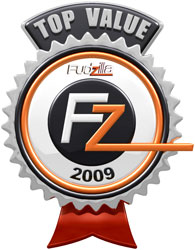Over the past few
years of its young foundations in the PC hardware industry, Silverstone has
taken upon itself a philosophy of engineering design excellence in its wide
range of cases, power supplies, and accessories. From its recent start in 2003,
the company has pushed itself to strive for first class aesthetic appeal in
every product it manufactures. Nevertheless, what results when a top-tier power
supply manufacturer combines the expertise of uniquely innovative engineers to
develop its flagship work of art is simply astounding in the long line of human
technological advancement.
Our friend Tony Ou, Product Manager at Silverstone sent us a
review sample of the company’s latest extreme high-end, industrial strength, enthusiast-oriented
power supply unit that uniquely matches this description of technological excellence,
the Silverstone Strider ST1500 modular 1500w.
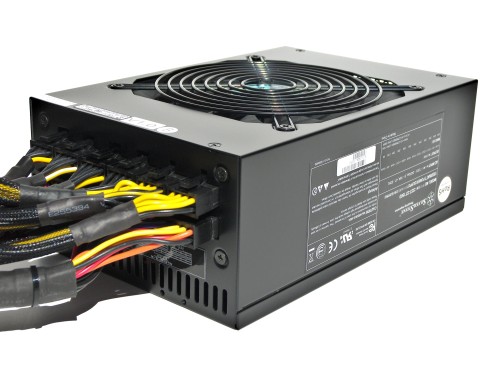
According to the company, reaching 1500W DC output (1600W
peak) with the Strider ST1500 is effectively the limit of what an internal PC
power supply can achieve in terms of wattage rating. For SilverStone, getting
to this maximum power was only part of the goal for a consumer-level power
supply, so every desirable feature known was added to create a dream product.
The list starts with unprecedented eight +12V rails each capable of up to 25A
and continues with features such as 100% modular cables, "80 PLUS Silver" worthy
efficiency ratings, and a quietness level that matches most 500W power supply
units. If there is one upgrade that will likely outlast a PC enthusiast’s
interest in computing, the ST1500 may just be it.
As with any flagship power supply unit, there is a hefty yet
analytically reasonable price point to pay. In the case of the Strider 1500w,
this price averages around $399, however don’t let it sink your hopes for an
upgrade too low in the dirt. This unit is absolutely the best prepared, solidly
built piece of power equipment we have ever had the opportunity to lay our hands
on.
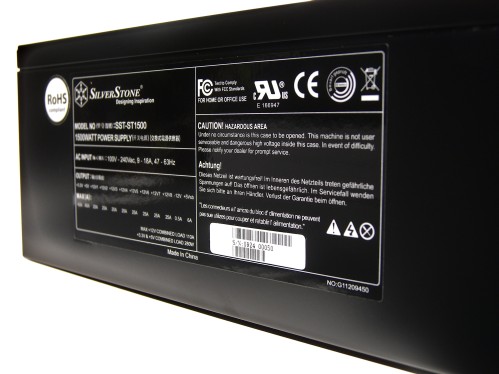
At the foremost center of its hardware specifications lies
an "80 PLUS Silver" certification stamp, meaning that it has been tested and
guaranteed to run at 85
percent efficiency during absolute peak load conditions. It features a
maximum load potential of up to 1600W across the entire unit, and up to 1320W
at 120A across its eight +12v rails. Additionally, this PSU is rated at a full 100,000
mean time before failure (MTBF) hours at 25C during peak load. It also features
an Active Power
Factor Corrector (PFC) system that efficiently controls the amount of power
drawn during load in order to obtain a power factor as close as possible to the
real amount of power flowing into the unit.
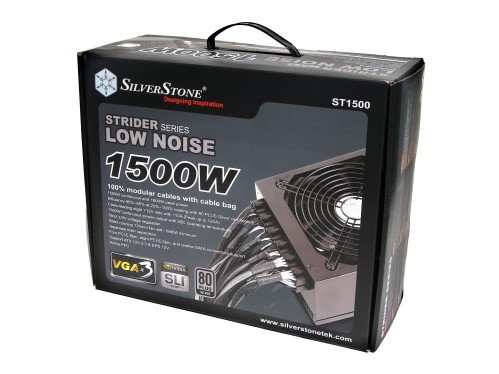
Upon first inspection of the packaging, the box weighed in
at an average proportion of what we would expect from a massive enthusiast
power supply. The unit itself measures in at 150mm (W) × 86mm (H) × 220mm (D), noticeably
larger than the average 750W to 1200W models currently on the market. The box
itself was nondescript, featuring several photos that show the
proprietary and practical marketing points, the cables, and the accessories
included.
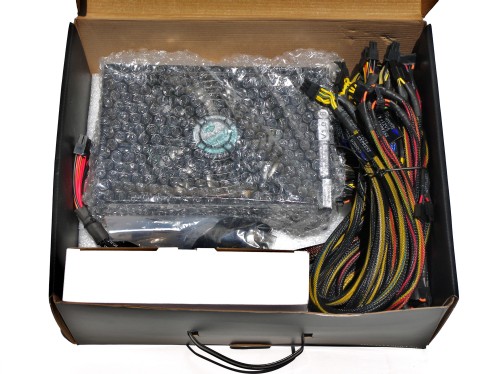
The packaging included the power supply unit itself in
bubble wrap with every included cable already connected to it. This was
convenient for showing off the beastly size of the unit to our friends, as we
could just grab all 9.25 pounds of it by the bulky cables in an angler-style
manner. After unpacking, not a dent, scratch, or smudge was to be seen – just a
matte black PSU and some rather tough looking modular cables with black
sleeving most similarly resembling those found on PC Power & Cooling units.
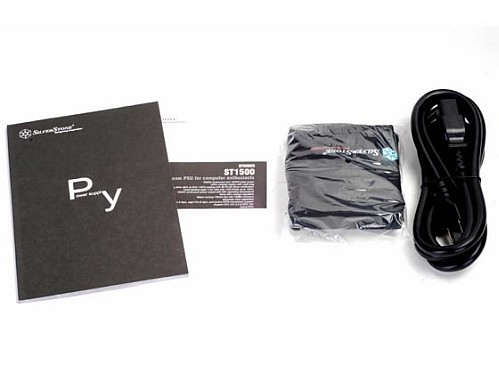
Installation could not have been any easier, simply because
Silverstone had already attached all the cables to the back of the PSU straight
out of the package. This allowed us to unplug the ones we didn’t need for our
system, while the rest were left in place. The physical flexibility of the modular
cabling is very similar to any BFG or PC Power & Cooling unit with yellow
and black cables enclosed in black netting – they bend to almost any desirable shape
and maintain it. In contrast, the Topower 1200W unit that we recently tested
had non-molding cables that maintained their strength while being flexed during
installation.
The Strider 1500W comes with four PCI-Express 8-pin cables
and four PCI-Express 6-pin cables, meaning a total of four Geforce GTX 295 or
similar future cards can be easily installed without any Molex adapters, so
long as the motherboard permits for such GPU space. This automatically makes
the PSU well equipped for even the most demanding of Folding@home farming
setups. It also comes with twelve SATA power connectors, twelve Molex
connectors, one 24-pin ATX connector, one 8-pin EPS +12v connector, and one 4+4
pin EPS +12v connector.
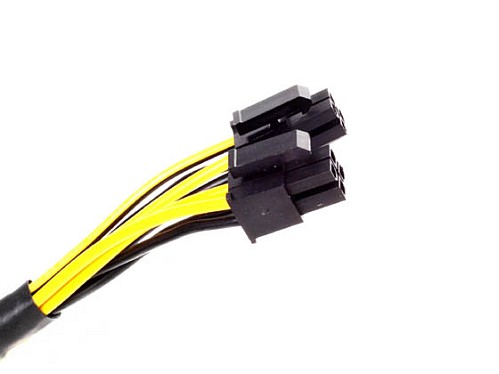
The 4 + 4 pin EPS +12v design conveniently allows for
adjustment to various motherboard power requirements. In the case of the EVGA
X58 SLI Classified and several other high-end enthusiast boards, the 4 + 4 pin
and the 8 pin EPS +12v connectors are both used.
The power cable included is a thick 14AWG with a squared-off
three prong connection design, meaning that conventional computer power cables will not fit
in this unit. Unfortunately, the biggest concern we have with the design of the
Strider 1500W is that it does not feature an On/Off switch. This could be an
inconvenience for several reasons most commonly associated with overclocking,
removing hardware, installing hardware, grounding, and other purposes.
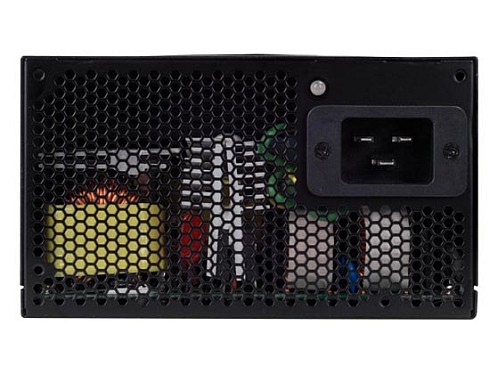
Testing the power
supply – idle desktop and full-power gaming
The core hardware of our test configuration consisted of an
EVGA X58 SLI Classified E759 (nForce 200) motherboard, an Intel Core i7 Extreme
965 at 3.74GHz and 1.34v, and 6GB of Mushkin XP Series DDR3 1600MHz 7-8-7-20 in
triple-channel mode. To top it off, we used three EVGA Geforce GTX 295 Plus
Edition dual-PCB cards all overclocked to 680/1483/1055MHz.
Our peripheral hardware consisted of a Thermalright TRUE
Copper with dual Noctua NF-12P fans in push-pull configuration, two Samsung
Spinpoint F1 750GB RAID Edition drives running Windows 7 Ultimate x64 RTM, and
a Sony BDU-X10S Blu-ray ROM drive. All in all, our system was definitely ready
to face the most industrial strength enthusiast power supply unit on the
planet, the Silverstone Strider 1500W.
On the Windows 7 desktop, our review unit did quite well at
handling idle system performance. As expected, all eight +12v rails maintained
solid input load balance within +0.3v of operation, while the +3.3v rail
measured in at a stable +3.30v and the +5v at +4.96v. Everything was running in
great shape, and to be honest there was a noticeable difference in the heat
output of our GTX 295s compared to the previous power configuration we had been
using. It had been a PC Power & Cooling Silencer 750W coupled with an FSP
Group X5 450W booster (for the PCI-E 6+2 pin inputs). Our graphics cards were
emitting 3C less heat than they had previously been, and we were very pleased
with this so we decided to investigate a little further
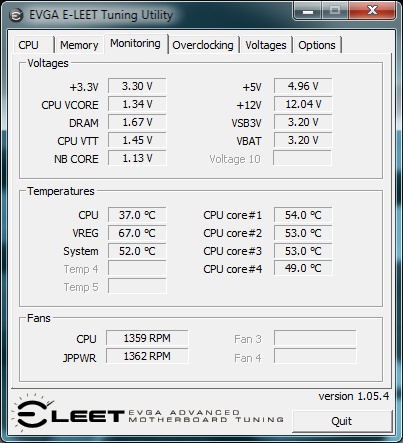
Although the company did not put any particular marketing
emphasis on the protection that the device provides from electromagnetic
interference, we take this vital precaution seriously due to the indefinite
nature and effects of EMF on the lifetime of system components. As a result, we
decided to go ahead and measure the electromagnetic interference levels coming
from all four PCI-E power cables. We grabbed our F.W. Bell
4100 Series Gauss Meter (pictured below) and found the results to be very
acceptable, however not exceptional. Where any number below 2mG of radiation constitutes
an “acceptable” level for a human living environment, the PCI-E cables
themselves averaged between 6.1mG and 9.7mG depending on GPU load. In
comparison, our testing room atmosphere away from our system measured in
between 0.3mG and 0.5mG depending on our location in the room. We then decided
to measure the top of the PSU unit itself just for fun, directly above the fan,
and it measured in between 406mG and 428mG during idle system load. This is
definitely not a power supply that you want to put your hand on for any inappropriate
period of time.
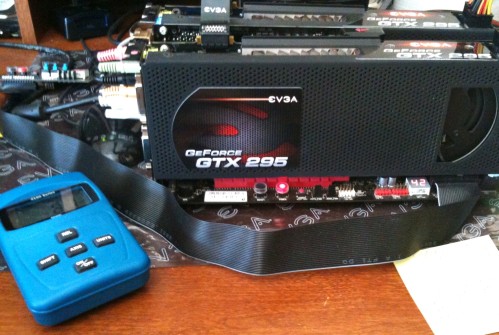
Mirror's Edge, Far Cry 2 and Crysis Warhead were our games
of choice when it came to measuring system load on the Silverstone Strider 1500W. We
did some pre-analysis and determined that Mirror’s Edge would make good use of
GPU PhysX, but wouldn’t entirely max out our input load. Far Cry 2 would be a
middle comparison solution, and Crysis Warhead would be the great system
stressor due to its ridiculous dependency on raw GPU acceleration as well as its heavy strain on the SLI link
running through the integrated memory controller on our Nehalem-based
motherboard.
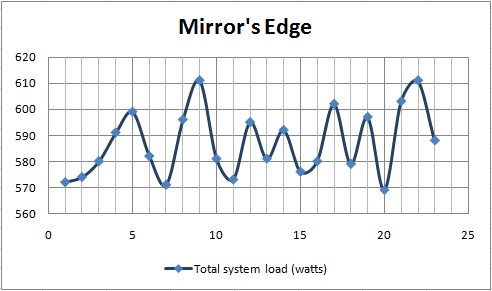
The Mirror’s Edge in-game stress test ran as expected, with
an average draw of around 561W on maximum settings with PhysX enabled at
1920x1080 resolution, 16x AF, High Quality texture filtering and Ambient
Occlusion enabled. In comparison, the Topower 1200W that we recently tested
averaged around 571W in this test.
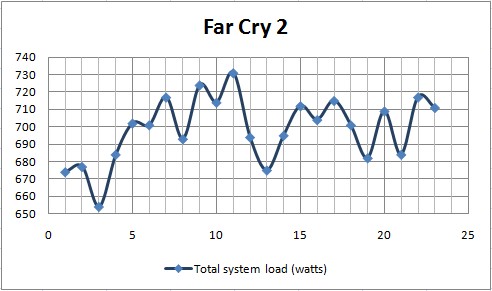
The Far Cry 2 in-game stress test added both more CPU and
GPU load to the total system draw, with an average of 568W on maximum settings
in DirectX 10 mode at 2048x1152 resolution, 4x AA, 16x AF, High Quality texture
filtering and Ambient Occlusion enabled. In comparison, the Topower 1200W averaged
around 684W in this test.
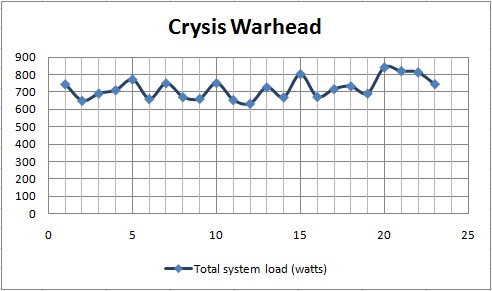
Finally, our ultra in-game stress test with Crysis Warhead taxed
the PSU unit the hardest, with an average power draw of 726W on completely
maxed out settings in DX9 mode (for optimal performance and quality) at
2048x1152 resolution, 16x AF, High Quality texture filtering and Ambient
Occlusion enabled. In comparison, the Topower 1200W averaged around 814W in
this test. With each live in-game test running for about twenty-five minutes
each, the Silverstone Strider 1500W took our system stress load quite well, and
we are definitely pleased with the efficiency of this unit.
Testing the power
supply – Folding@home
Now, it was time to initiate the next level of system
stress. We plugged in all three of our EVGA GeForce GTX 295 Plus Edition
dual-PCB overclocked cards and attempted to run a breathtaking science
experiment – six Folding@home Nvidia GPU clients running across all six 55nm
GT200 chips in harmony.
Unfortunately, Windows Vista and Windows 7 both require that
a monitor be plugged into each active GPU core in order for Folding@home to
work, and we aren’t the kind of people with five extra monitors laying around
at hand. Thankfully, there is a nifty and inexpensive workaround to trick the native
Windows OS display drivers into thinking that there are multiple monitors
attached to the system, and that is simply by creating dummy VGA adapter plugs.
Trubritar has a great
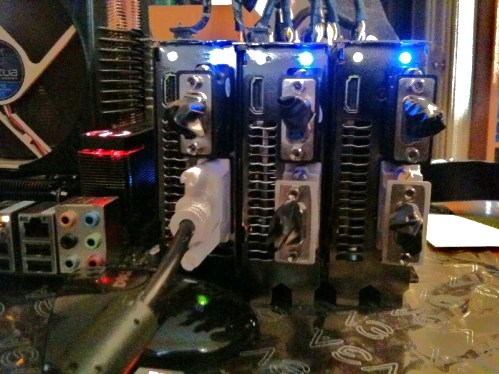
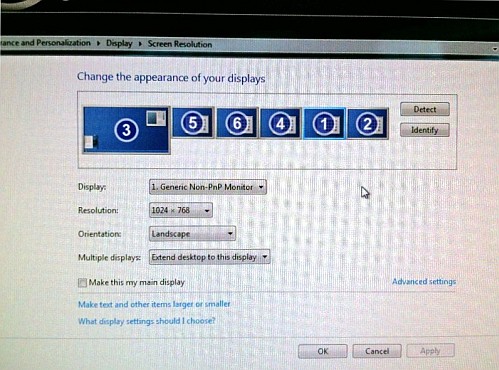
Our total system load with three GTX 295s at peak GPU stress and six instances of Folding@home managed to fluctuate very slightly, staying between 801W and 811W. In contrast, idle power draw on the Windows 7 desktop managed to stay around 443W with all three cards and managed to stay around 364W with just two cards.
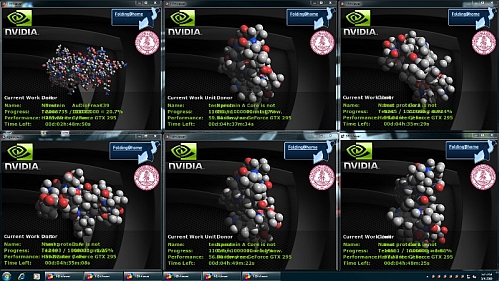
After a long afternoon's work, the final result was promising, however very loud. We cranked up the fan speed on the GTX 295s to 100 percent and literally recreated the Mojave Desert on the desk. The heat was ridiculous and the cards were scalding hot to the touch. After the twenty-five minute test run, we quickly shut off the system, grabbed the graphics cards in our hands while literally playing hot potato and ran outside with them to let them cool off in the summer breeze.
Audible noise impressions
The Strider ST1500 is equipped with a powerful yet deadly silent 135mm fan with automatically adjustable speed according to the unit temperature, which we were very pleased with listening to during normal operation. Upon system startup, the power supply unit was completely inaudible, and is by far the quietest power supply we have ever used. During our loading to the desktop in Windows 7, we isolated the rest of our active system noise with some egg crates as best we could. The result was very promising, as the 135mm fan gave roughly 13dBa to 19dBa of audible output depending on the listening distance. In reality, we had put our ear right on the fan to actually hear any humming.
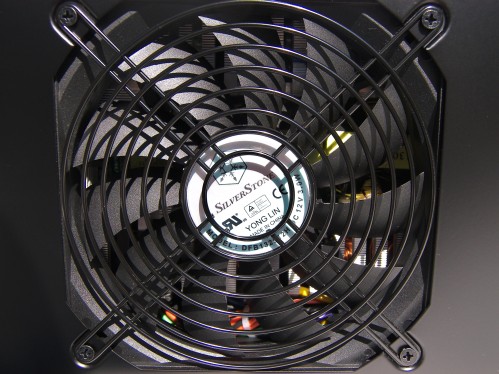
Final thoughts and conclusion
Without a doubt, the Silverstone Strider ST1500 modular 1500w is the most powerful and efficient power supply unit we have ever used. It features a peak output of 1600W across all system components, with an impressive 1320W at 120A just for the eight rock-solid +12v rails. Our Folding@home test with three overclocked GTX 295s running on the enthusiast favorite Intel Nehalem platform barely put out a peak load of 811W, and in independent mess-around testing we could not even get our system past a kilowatt load without ridiculous heat output. To top it off, this power supply offers every DC electrical protection in the book – over current, under voltage, over voltage, short circuit, no load, and over power protection with an impressively high 85 percent "80 PLUS Silver" efficiency rating at 100 percent peak load. Finally, the 135mm silent fan design effectively eliminates any and all audible noise from within a closed case or open-end environment. Our overall impressions from the subjective analysis we gave on the low decibel levels on this unit further added bonus to the overall value of the product, and we are centrally impressed with the efficiency, stability, and silence of operation that the Silverstone Strider 1500w has to offer. It should definitely be the top choice for any enthusiast looking for the optimal balance of these three focus points and a solid system investment that should last an incredibly long time.
